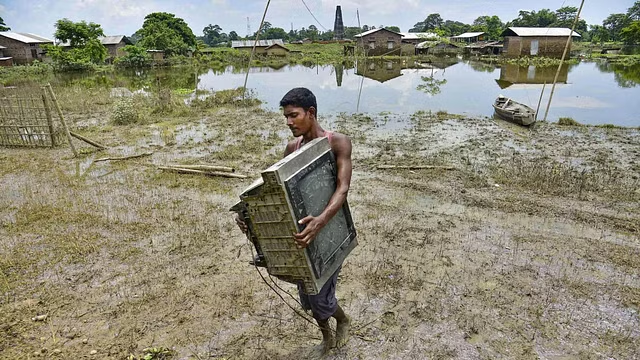The flood situation in Assam has shown significant improvement over the past few days, with water levels receding across the state. Despite the improvement, the death toll has risen to 112, with the latest fatalities reported from Karimganj and Nilambazar revenue circles of Karimganj district. the Assam State Disaster Management Authority (ASDMA) has been operating 172 relief camps and relief distribution centers in 13 districts, providing support to 58,816 displaced people.
Key Statistics
- Death Toll: The death toll has risen to 112, with the latest fatalities reported from Karimganj and Nilambazar revenue circles of Karimganj district.
- Affected Population: Nearly 6 lakh people are affected across 17 districts, with Cachar being the worst hit, followed by Dhubri and Nagaon.
- Displaced People: 58,816 people are currently living in relief camps and distribution centers.
- Damaged Areas: 1,342 villages and 25,367.61 hectares of crop area have been damaged across Assam.
- Infrastructure Damage: Embankments, roads, bridges, and other infrastructure have been damaged in several districts, including Dhemaji, Golaghat, Nagaon, Tamulpur, Cachar, Chirang, Darrang, Dhubri, Goalpara, and Karimganj.
- Animals Affected: Over 2,83,700 domestic animals and poultry have been affected by the floods.
Relief Efforts
The state administration has been working tirelessly to provide relief to the affected population. Relief camps and distribution centers have been set up in various districts, catering to the needs of displaced people. The ASDMA has been monitoring the situation closely and providing necessary support to the affected areas.
Brahmaputra River Situation
The Brahmaputra River is flowing above the danger mark at Nimatighat, Tezpur, and Dhubri. Its tributaries, Burhidhing at Chenimari and Disang at Nanglamiraghat, are also flowing above the danger level. This has exacerbated and flood situation in several areas, leading to widespread damage and displacement.
Support from Other States
In a show of solidarity, the Chief Minister of Odisha, Naveen Patnaik, has offered assistance to the people of Assak affected by the floods. Similarly, Union Home Minister Amit Shah has also extended his support to the state, promising all necessary help to mitigate the situation.
Future Plans
The state government is working on a comprehensive plan to address the long-term impact of the floods. This includes rebuilding damaged infrastructure, providing compensation to affected farmers, and ensuring the safety of the displaced population. The government is also focusing on improving flood management systems to prevent similar disasters in the future.
Conclusion
While the flood situation in Assam has improved significantly, the state is still grappling with the aftermath of the disaster. The support from other states and the central government is crucial in this time of need. The state administration is working diligently to provide relief and rehabilitation to the affected population, and the people of Assam can expect continued support as they recover from this devasting event.
